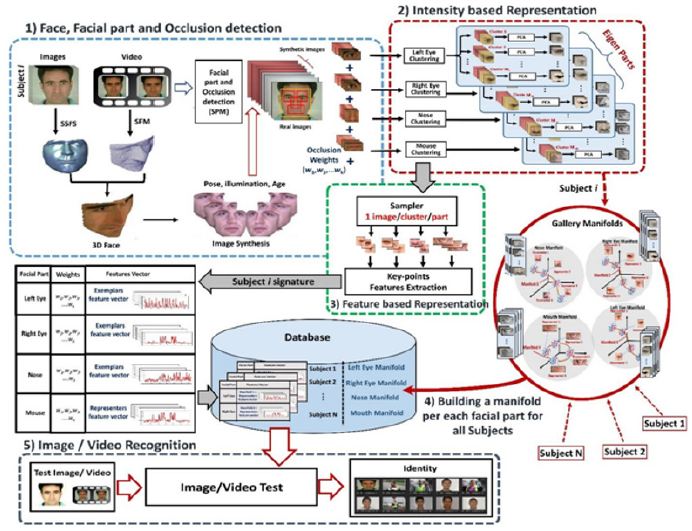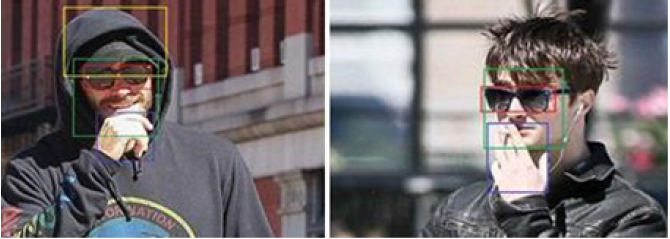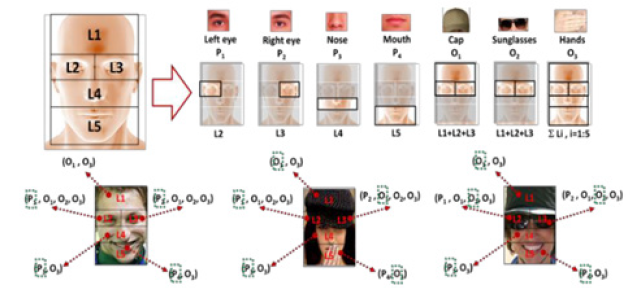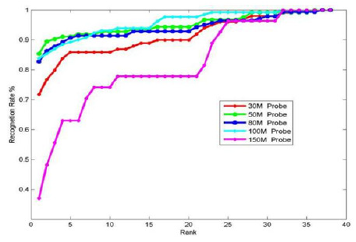- Submissions

Full Text
COJ Electronics & Communications
Robust Representation for Face Recognition in the Wild
Mostafa Farag, Mostafa Abdelrahman, Ahmed El-Barkouky, Eslam Mostafa, James Graham and Aly A Farag*
Fellow, IEEE and IAPR Computer Vision and Image Processing Laboratory, University of Louisville, USA
*Corresponding author: Aly A Farag, Fellow, IEEE and IAPR Computer Vision and Image Processing Laboratory, University of Louisville, Louisville, KY, USA 40292
Submission: April 07, 2020;Published: June 02, 2021

ISSN 2640-9739Volume2 Issue1
Abstract
This paper describes a generalized representation for face recognition in the wild using still and video imaging, addressing unconstrained recognition under A-PIE effects. The proposed representation uses images and video frames for generating the facial signatures for face recognition. The representation allows for inclusion of all video frames in generating the facial signature and is also amenable to “best frames” selection and “intelligent priors” about facial regions in the image/video. The representation includes dual optimization for signature extraction and signature matching over large gallery manifolds. It is modular and amenable to deployment on distributed systems, smart phones and on the cloud. Results, in a Face Recognition at a Distance (FRAD) setup, for detection of faces under severe occlusion, pose-invariant face detection and recognition, on databases created by high resolution camera (Canon 7D: 18MP) and iPhone 4 low-resolution camera (5MP), give credence to the proposed representation.
Keywords: Face recognition in the wild; Selective Part Model (SPM); Gallery manifolds; Pose-invariance; Illumination models; Deep learning; Feature selection; Matching
Introduction
Research in face recognition deals with problems related to Age, Pose, Illumination and
Expression (A-PIE), and seeks approaches that are invariant to these factors. Video images
add a temporal aspect to the image acquisition process. Another degree of complexity, above
and beyond A-PIE recognition, occurs when multiple pieces of information are known about
people, which may be distorted, partially occluded, or disguised, and when the imaging
conditions are totally unorthodox! Face Recognition in the Wild has emerged as a field of
research in the past few years. Its main purpose is to challenge constrained approaches of
automatic face recognition, emulating some of the virtues of the Human Visual System (HVS),
which is very tolerant to age, occlusion, and distortions in the imaging process. HVS also
integrates information about individuals and adds contexts together to recognize people
within an activity or behavior. Machine vision has a very long road to emulate HVS, but face
recognition in the wild, using the computer, is a road to perform face recognition in that
path. Our research group has been developing a front-end approach for face recognition in
the wild, which builds on the state-of-the art in theory and algorithms of facial biometrics
and builds upon our own contribution in pose-invariance, illumination modeling and
feature optimization. Our approach hinges on two major building blocks: representation
and recognition. Representation: constructs a robust representation for faces (from video,
still images and other media) into a gallery that is easy to enroll and search. Recognition:
constructs an approach to detect faces (from video, still images and other media), and extract
expeditiously an optimum feature vector for discriminatory facial key points (around the
eyes, nose and lips), suitable for matching with candidate faces in the gallery.
We shall refer to sample references most pertaining to the work proposed in this manuscript.
The team has the following contributions: i) Built a front-end Biometric Optical Surveillance
System (BOSS) for unconstrained Face Recognition at a Distance (FRAD) up to 150 meters
[1-5]; ii) developed a methodology to detect and track multiple faces [6]; iii) developed a pose-invariant approach for face recognition at a distance [7,8]; iv)
developed an image illumination model for generalized lighting and
object characteristics, which corrects for illumination variations at
random poses [9-12]; v) developed a heat-kernel approach for face
recognition suitable for part-based and holistic face recognition
[13]; vi) developed face recognition on low-resolution thermal and
video imaging [14,15]; vii) developed facial biometric systems for
study of autism, involving man-machine interfaces with humanoid
robots, non-intrusive vital sign, and expression measurements for
behavioral studies of people with special needs [16,17].
The contributions of this paper are:
Proposed Representation
a. introducing novel representation for face recognition in
the wild for video and still imaging addressing the most general
view of A-PIE imaging conditions;
b. describing how the representation enables model-based
design and evaluation of the three major components of face
recognition: face detection, facial feature extraction, and face
recognition; and
c. Provide sample evaluations for the proposed
representation in an outdoor and indoor settings, using high
and low resolution cameras, for Face Recognition at a Distance
(FRAD).
Figure 1 illustrates the proposed representation for face
recognition in the wild. Starting from the given data set all the
faces will be detected and tracked. We assume that this data will
not be complete to describe variation in age, pose, illumination,
and expression of the subject under modeling. To complete this
data set, we generate an accurate 3D reconstruction, which enables
generating novel poses, correct for illumination variations. Two
approaches have shown promise for generating the sparse 3D
reconstruction: (i) Statistical Shape from Shading (SSFS) which
uses databases of shapes and albedos and deploys spherical
harmonics and partial least square optimization to generate a
3D reconstruction from a single image [5,9,11]; (ii) Structure
from Motion (SFM) (e.g., [18,19]). This route uses all advances in
appearance modeling and object reconstruction from a sequence
of images in the computer vision literature in the past two decades.
Illumination models from Computer vision (e.g., [20,21]), computer
graphics and computational photometry (e.g., [22]) will be used
for proper modeling of illumination. From detected facial regions
extracted from original images or videos and novel generate
synthetic images (real+synthetic), four facial parts (right and left
eyes, nose and lip) will be extracted using a Selective Part Model
(SPM) [6]. The SPM generates ensemble of the left eyes, right eyes,
nose and lips. These ensembles are descriptive of various forms of
the parts; e.g., close eyes, occluded eyes; occluded nose, smile lips,
closed lips, open lips, etc. Hence, per each region, we will have a
set of sub-classes { ,∈ [1,4]; = } for each part and their occlusion is
given a weight.
We propose to generate an optimal set of images per part subclasses
{ ,∈ [1,4]; = } using clustering techniques–this is to minimize
the within class scatter and maximize the between class scatter, in
each of the part sub-class. The output of this step is an ensemble of
parts (the sub-classes per part) with fewer redundancies. They are
“images.” In this step, we follow a similar approach to See & Swaren
[23]. The exemplar technique will select from the original data (if
available) over the generated synthetic data (Figure 1). Then we
may follow either of two parallel routes to generate the optimal
representation:
a. An image-based route will map the inference on clusters
of face parts to Grassmann manifold, which captures the global
characteristic of the local clusters of face part. We will have four
manifolds one for each part.
b. A feature-based route which captures variations within
every part clusters, by exemplar sample which can be the mean
of each cluster. Then 2D signatures, (e.g., LBP, Gabor wavelet,
LOIP, ORB) are reconstructed around each key-point (e.g., Rara
[2]) for each sample image.
The features (very large vector) may be optimized by various
learning approaches and used to build the gallery together with
the four manifolds. Novelty in this representation includes adding
the Selective Part Model (SPM) for facial feature extraction [6]
and the SFM [19] for sparse facial key point reconstruction.
Novelty also includes developing novel learning methods for
feature optimization using SVM and Deep Learning, in addition to
traditional PCA, and Simulated Annealing.
Figure 1: Proposed representation pipeline. From detected facial regions in images or videos, four facial parts (right and left eyes, nose and lip) are extracted from original and novel poses; and their occlusion is given a weight. An elaborate process is used to optimize the features, per part, and assign them a node in the gallery manifold. In the recognition phase, features from detected facial images or videos are detected on the fly, and their features are extracted and used in matching with candidate objects in the gallery manifold using optimal search methods. The framework has five main components, the input/output of every component will be as following: 1) the first component takes the detected faces as an input and generates face parts plus feature points in every part plus occlusion weight. 2) The second component takes the face parts and cluster each part image to fixed number of clusters and generate the cluster’s PCA projection for the four face parts. 3) The third component takes the clusters then samples each cluster and extract 2D signatures for each sample with the occlusion weight. 4) The fourth component take the PCA projects and draw the inference on cluster of each face part manifold. 5) The fifth component takes test (probe) image or video and applies the procedure described in the following subsection and search the gallery for the matched identity.

Recognition
Given an image, video and other media that conveys information about an individual, we extract the facial regions in the image as a whole using home grown approach [24] and extract the facial parts (eyes, nose and lips) using an enhanced selective part model, and a false face reduction mechanism. The SPM [6] and facial features detection play dual roles: jointly enhance the facial detection and reduce false positives and create weighted features for recognition. The facial features will hinge on small patches around nine-key points on which we apply SIFT, SURF, LBP, ORB and other feature descriptors. The SPM model handles natural and self-created occlusions (Figure 2) and creates regions for the right and left eyes, the nose and the lips (Figure 3). Features for each of these parts will be created using various common attributes and geometric characteristics. The features from the descriptors and the SPM will be huge; hence, a learning module is essential to generate optimal set of features, which will be used in matching candidate face representations in the gallery. In all, the entire process is model-based and involves the latest in computer vision, computational photometry, machine learning and database design (e.g., [9,12,13,25]).
Figure 2: Detection of partially occluded faces, by considering sunglasses, caps and hands.

Figure 3: SPM for face detection under partial occlusion by caps, sunglasses and hands.

Evaluation
Gallery reconstruction
Case study: If the given input is a video, all the faces will be
detected and tracked in the frames (or assume that the detection and
tracking information is given with the provided data). For example,
given a five minute video with 30 fps, we will have 5*60*30=9000
frames. More than one subject in the video will be processed in
parallel in the following steps (Note: If the subject appears in 2
minutes of a five-minute video, we have 2*60*30=3600 frames.):
a. A 3D model will be generated using the statistical shape
from shading (SSFS) [5,11] and the structure from motion [19].
This 3D will enable generating a new set of synthetic images
with novel poses, age, and illumination variations.
b. A set of facial feature points (key-points) will be detected
in each face for the given and generated images.
c. The detected faces will be divided into four parts or
segments of facial regions as: forehead, right and left eyes, nose,
and lips (e.g., [11]). The detection step will provide a weight for
each face part as a measure for the occlusion level.
d. Cluster the image space of each face part into local clusters
using hierarchical agglomerative clustering (STHAC) algorithm
[e.g., [23]). If we consider 10 clusters, we will have 360 image in
each cluster per face part.
e. The PCA projection of the intensity of part images, and the
other is based on the local features of a sample image from each
cluster. The 2D signatures, (e.g., LBP, Gabor wavelet, LOIP, ORB)
are reconstructed around each key-point (e.g., [2]) for each
sample image – That is, we generate 10 feature vectors for each
part. These signatures will be enrolled to the database together
with the four manifolds. If the given input is a single image or
a small set of images, then all the steps above will be the same
except the 3D model will be reconstructed using the Statistical
Shape from Shading (SSFS) only.
Evaluation on images
a. Staring from detected face, facial feature points are
extracted.
b. The facial parts (eyes, nose and lips) are extracted using
the Selective Part Models (SPM) approach. The detection step
provides a weight as a measure for the occlusion level.
c. 2D signatures, (LBP, Gabor wavelet. LOIP, ORB, etc.),
are reconstructed around each key-point [3] for each sample
image. Features include LBP, Gabor Wavelet, FAST, BREEF, ORB
and LIOP.
d. These features, together with the weights, are used for
individual classifiers or in a decision fusion framework to
output the final result. Common classifiers include Support
Vector Machine (SVM), Dynamic Image to Class Warping
(DICW), and minimum distance (e.g., kNN) classifiers.
e. Recognition is obtained by decision fusion from each face
part.
Evaluation on video
a. Starting from the face detection and tracking in each
frame. A set of facial feature points (key-points) will be detected
in each face for the given images (e.g., [24]).
b. The detection step provides a weight as a measure for the
occlusion level. A false face reduction mechanism is deployed to
reject the false positive faces.
c. Each face part in all the frames is clustered to fixed
number of clusters (m-cluster). After clustering we have two
routes: one based on the PCA projection of the intensity of part
images, and the other is based on the local features of a sample
image from each cluster.
d. First route draws inference on cluster of each face part
manifold to capture the global characteristic of the local clusters
of this part. The first n component (Eigen vectors) of the PCA is mapped to one point on the part manifold. We have 10 points on
each manifold (one point for each cluster). A distance measure
to all other enrolled subjects on the manifolds is measured
based on the geodesic distance. Then an identity decision is
decided from the four manifolds.
e. For the second route, the variations within the local
clusters are captured by exemplar sample, which can be the
mean of each cluster. Assuming 10 clusters, each cluster has
360 images, selecting one image from each cluster so we will
have 10 sample images for each part.
f. 2D signatures, (LBP, Gabor wavelet. LOIP, ORB, etc.), are
reconstructed around each key-point (e.g., [2]) for each sample
image (10 feature vectors for each part).
g. A sample from each cluster is selected and used for
recognition against the gallery as the case of a single image.
These provide an identity label from each sample.
h. Recognition is decided using decision fusion techniques.
Results
The proposed representation in (Figure 1) is modular, enabling various scenarios of face recognition in the wild. Space limitations dictated removal of various performance curves. We only show sample results. Figure 4 shows recognition for the representation in an image-based outdoor face recognition at a distance (The BOSS system [1-5]). The system used Canon EOS 7D: 18MP camera. 11 subjects for five distances: 9 poses (3 for Yaw, Pitch and Roll), outdoor sunny illumination, and modest expression per setting. Gabor and LBP features were used and a kNN distance classifier. Various combinations of facial occlusions were deployed (caps, sunglasses, eyeglasses, makeup, hoodies, etc.). Computation were on 8 CPU machine, un-optimized code; decision took 40sec from enrollment to recognition (Figure 5). Components-wise evaluation of the proposed representation, for pose-invariant face recognition is in [8], and heat-kernel feature matching is in [13]. We also refer to the Master Thesis of the first author [15]. The results demonstrate flexibility of the proposed representation. Current efforts are focused on video FRAD in the wild.
Figure 4: Performance of FRAD setup with Canon EOS 7D: 18MP camera.

Figure 5: Performance of FRAD setup with iPhone 4: 5 MP camera.

Conclusion
This paper presented a generalized representation for face recognition in the wild showing the major modular building blocks of face detection, signature generation and matching. The representation is the viewpoint of several years of research in this area by our group and is optimal, in many respects, for extreme imaging conditions. It is applicable for still images and video. Software and databases are available and may be requested from the contact author.
References
- Rara H, Elhabian S, Ali A, Miller M, Starr T, et al. (2009) Face recognition at a distance based on sparse-stereo reconstruction. IEEE CVPR Biometrics Workshop, USA.
- Rara H, Farag A, Davis T (2011) Model-based 3D shape recovery from single images of unknown pose and illumination using a small number of feature points. International Joint Conference on Biometrics (IJCB), pp. 1-7.
- Rara H, Elhabian S, Ali A, Miller M, Starr T, et al. (2010) Face recognition at-a-distance using texture and sparse-stereo reconstruction. Proc of IEEE Fourth International Conference on Biometrics: Theory, Applications and Systems (BTAS), pp. 1221-1224.
- Parris J, Wilber M, Helfin B, Rara H, El barkouky A, et al. (2011) Face and eye detection on hard datasets. International Joint Conference on Biometrics (IJCB), pp. 1-10.
- Rara H, Elhabian S, Starr T, Farag A (2010) 3D face recovery from intensities of general and unknown lightning using partial least squares. Proc of 2010 IEEE International Conference on Image Processing (ICIP), pp. 4041-4044.
- Elbarkouky A, Farag A (2013) Selective Part Model (SPM) for face detection. CVIP Lab TR-11-2013.
- Mostafa E, Farag A (2012) Dynamic weighting of facial features for automatic pose-invariant face recognition. Proceedings of Ninth Conference on Computer and Robot Vision, pp. 411-416.
- Mostafa E, Ali A, Alajlan N, Farag A (2012) An automatic pose invariant face recognition at distance approach. ECCV, Germany.
- Elhabian S, Rara H, Farag A (2011) Towards accurate and efficient representation of image irradiance of convex-lambertian objects under unknown near lighting. International Conference of Computer Vision (ICCV), pp. 1732-1737.
- Elhabian S, Rara H, Farag A (2011) Towards efficient and compact phenomenological representation of arbitrary bidirectional surface reflectance. In Proceedings of the British Machine Vision Conference (BMVC), pp. 89.1-89.11.
- Elhabian S, Mostafa E, Rara H, Farag A (2012) Non-lambertian model-based facial shape recovery from single image under unknown general illumination. Proceedings of Ninth Conference on Computer and Robot Vision (CRV’12), pp. 252-259.
- Elhabian S, Farag A (2013) Analytic bilinear appearance subspace construction for modeling image irradiance under natural illumination and non- lambertian reflectance. Proceedings of Computer Vision and Pattern Recognition, CVPR.
- Abdelrahman M, Farag A, Elmelegy M (2013) Heat front propagation contours for 3D face recognition. Proc of IEEE Sixth International Conference on Biometrics: Theory, Applications and Systems (BTAS’13), USA.
- Mostafa E, Hammoud R, Ali A, Farag A (2013) Face recognition based on local descriptors of facial features in low resolution thermal images. Journal of Computer Vision and Image Understanding.
- Farag M (2013) Face recognition in the wild. Master of Engineering Thesis, University of Louisville, USA.
- Niese R, Al Hamadi A, Farag A, Neumann H, Michaelis B (2011) Facial expression recognition based on geometric and optical flow features in colour image sequences. British Computer Vision Journal.
- El Barkouky A, Mahmoud A, Graham J, Farag A (2013) An interactive educational drawing system using a humanoid robot and light polarization. International Conference of Image Processing.
- Forsyth DA, Ponce J (2002) Computer vision: A modern approach. Prentice Hall Professional Technical Reference, USA.
- Garg R, Roussos A, Agapito L (2013) Dense variational reconstruction of non-rigid surfaces from monocular video. CVPR, IEEE, USA.
- Belhumeur PN, Kriegman DJ (1998) What is the set of images of an object under all possible illumination conditions? International Journal of Computer Vision 28: 245-260.
- Basri R, Jacobs D (2003) Lambertian reflectance and linear subspaces. IEEE Transactions on Pattern Analysis and Machine Intelligence 25(2): 218-233.
- Ramamoorthi R, Hanrahan P (2002) Frequency space environment map rendering. ACM Transactions on Graphics 21(3): 517-526.
- See J, Eswaran C (2011) Video-based face recognition using spatio-temporal representations. In Tech Open Access Publisher, UK, pp. 1-20.
- Mostafa E, Farag A (2012) Complex bingham distribution for facial feature detection. Proceedings of European Conference on Computer Vision Workshops (ECCV’12 Workshops), pp. 330-339.
- Rara H (2011) 3D facial shape estimation from a single image under arbitrary pose and illumination. CVIP Lab, University of Louisville, USA.
© 2020 Aly A Farag. This is an open access article distributed under the terms of the Creative Commons Attribution License , which permits unrestricted use, distribution, and build upon your work non-commercially.
 a Creative Commons Attribution 4.0 International License. Based on a work at www.crimsonpublishers.com.
Best viewed in
a Creative Commons Attribution 4.0 International License. Based on a work at www.crimsonpublishers.com.
Best viewed in 







.jpg)






























 Editorial Board Registrations
Editorial Board Registrations Submit your Article
Submit your Article Refer a Friend
Refer a Friend Advertise With Us
Advertise With Us
.jpg)






.jpg)














.bmp)
.jpg)
.png)
.jpg)










.jpg)






.png)

.png)



.png)






